2019 Hyundai Tucson headlamp
[x] Cancel search: headlampPage 485 of 685
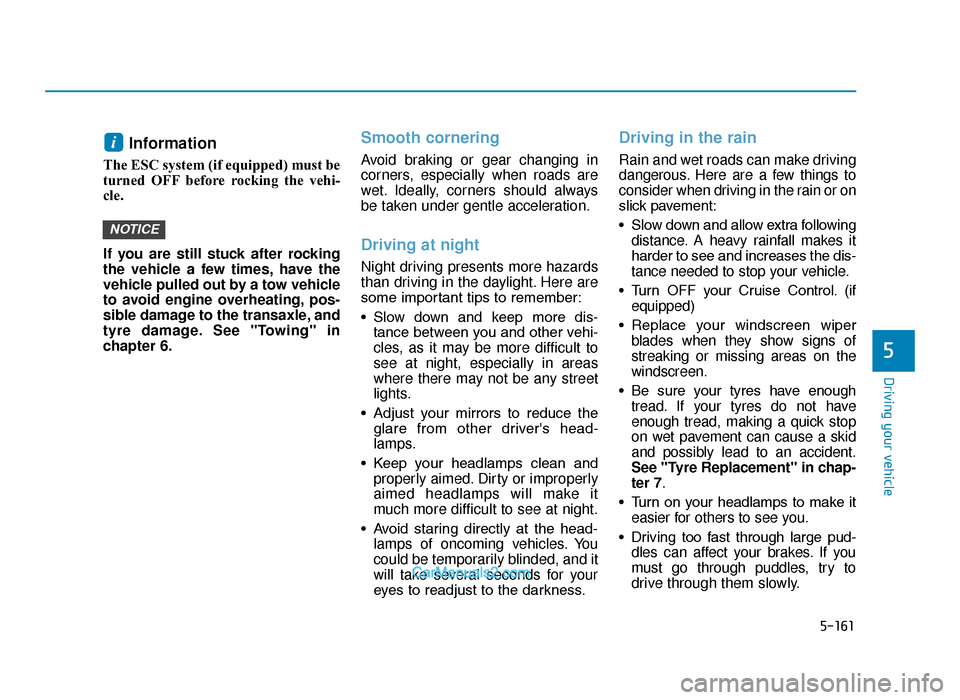
5-161
Driving your vehicle
5
Information
The ESC system (if equipped) must be
turned OFF before rocking the vehi-
cle.
If you are still stuck after rocking
the vehicle a few times, have the
vehicle pulled out by a tow vehicle
to avoid engine overheating, pos-
sible damage to the transaxle, and
tyre damage. See "Towing" in
chapter 6.
Smooth cornering
Avoid braking or gear changing in
corners, especially when roads are
wet. Ideally, corners should always
be taken under gentle acceleration.
Driving at night
Night driving presents more hazards
than driving in the daylight. Here are
some important tips to remember:
• Slow down and keep more dis-tance between you and other vehi-
cles, as it may be more difficult to
see at night, especially in areas
where there may not be any street
lights.
• Adjust your mirrors to reduce the glare from other driver's head-
lamps.
• Keep your headlamps clean and properly aimed. Dirty or improperly
aimed headlamps will make it
much more difficult to see at night.
• Avoid staring directly at the head- lamps of oncoming vehicles. You
could be temporarily blinded, and it
will take several seconds for your
eyes to readjust to the darkness.
Driving in the rain
Rain and wet roads can make driving
dangerous. Here are a few things to
consider when driving in the rain or on
slick pavement:
• Slow down and allow extra followingdistance. A heavy rainfall makes it
harder to see and increases the dis-
tance needed to stop your vehicle.
• Turn OFF your Cruise Control. (if equipped)
• Replace your windscreen wiper blades when they show signs of
streaking or missing areas on the
windscreen.
• Be sure your tyres have enough tread. If your tyres do not have
enough tread, making a quick stop
on wet pavement can cause a skid
and possibly lead to an accident.
See "Tyre Replacement" in chap-
ter 7.
• Turn on your headlamps to make it easier for others to see you.
• Driving too fast through large pud- dles can affect your brakes. If you
must go through puddles, try to
drive through them slowly.
NOTICE
i
TLe UK 5.qxp 5/10/2018 12:32 PM Page 161
Page 551 of 685
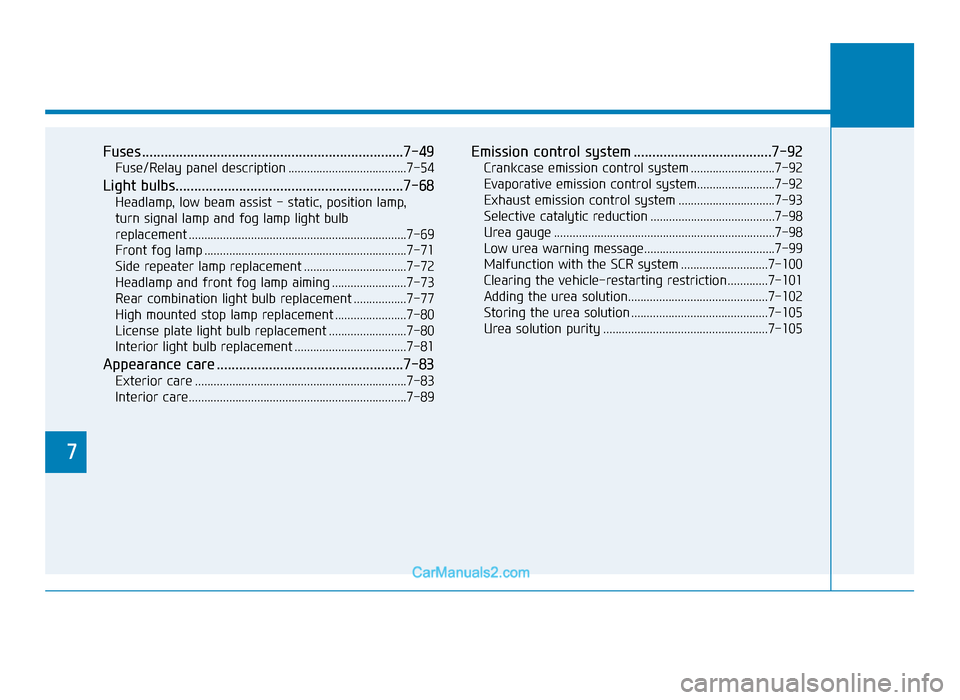
7
Fuses ......................................................................7-\
49
Fuse/Relay panel description ......................................7-54
Light bulbs.............................................................7-68
Headlamp, low beam assist - static, position lamp,
turn signal lamp and fog lamp light bulb
replacement ......................................................................7-\
69
Front fog lamp .................................................................7-71
Side repeater lamp replacement .................................7-72
Headlamp and front fog lamp aiming ........................7-73
Rear combination light bulb replacement .................7-77
High mounted stop lamp replacement .......................7-80
License plate light bulb replacement .........................7-80
Interior light bulb replacement ....................................7-81
Appearance care ..................................................7-83
Exterior care ....................................................................7-83\
Interior care......................................................................7-\
89
Emission control system .....................................7-92
Crankcase emission control system ...........................7-92
Evaporative emission control system.........................7-92
Exhaust emission control system ...............................7-93
Selective catalytic reduction ........................................7-98
Urea gauge .......................................................................7\
-98
Low urea warning message..........................................7-99
Malfunction with the SCR system ............................7-100
Clearing the vehicle-restarting restriction.............7-101
Adding the urea solution.............................................7-102
Storing the urea solution ............................................7-105
Urea solution purity .....................................................7-105
TLe UK 7.qxp 5/10/2018 1:31 PM Page 2
Page 559 of 685
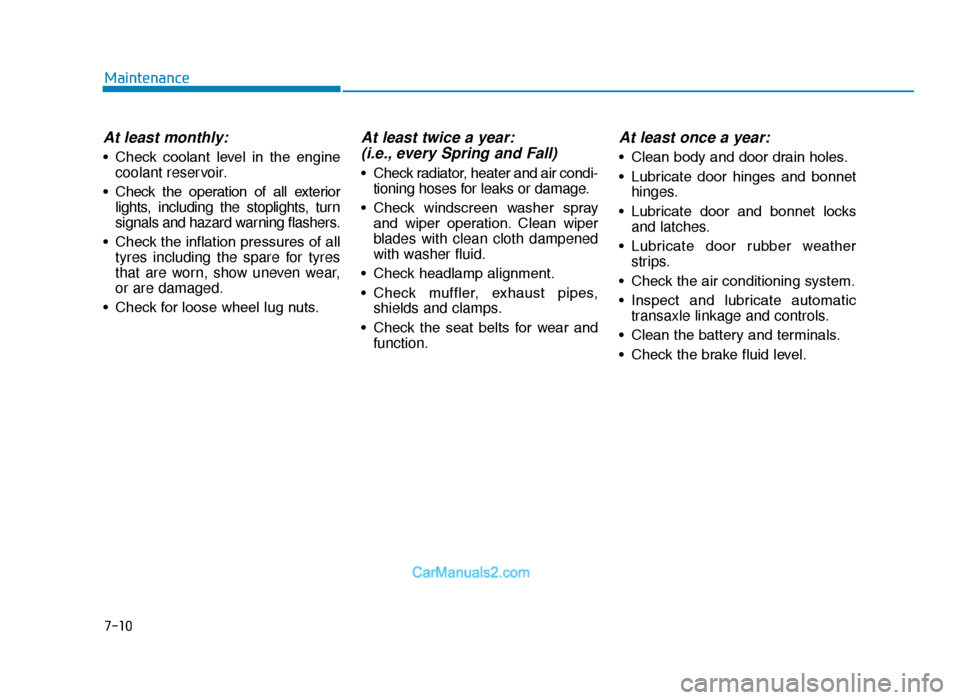
7-10
Maintenance
At least monthly:
• Check coolant level in the enginecoolant reservoir.
• Check the operation of all exterior lights, including the stoplights, turn
signals and hazard warning flashers.
• Check the inflation pressures of all tyres including the spare for tyres
that are worn, show uneven wear,
or are damaged.
• Check for loose wheel lug nuts.
At least twice a year: (i.e., every Spring and Fall)
• Check radiator, heater and air condi-
tioning hoses for leaks or damage.
• Check windscreen washer spray and wiper operation. Clean wiper
blades with clean cloth dampened
with washer fluid.
• Check headlamp alignment.
• Check muffler, exhaust pipes, shields and clamps.
• Check the seat belts for wear and function.
At least once a year:
• Clean body and door drain holes.
• Lubricate door hinges and bonnethinges.
• Lubricate door and bonnet locks and latches.
• Lubricate door rubber weather strips.
• Check the air conditioning system.
• Inspect and lubricate automatic transaxle linkage and controls.
• Clean the battery and terminals.
• Check the brake fluid level.
TLe UK 7.qxp 5/10/2018 1:32 PM Page 10
Page 617 of 685
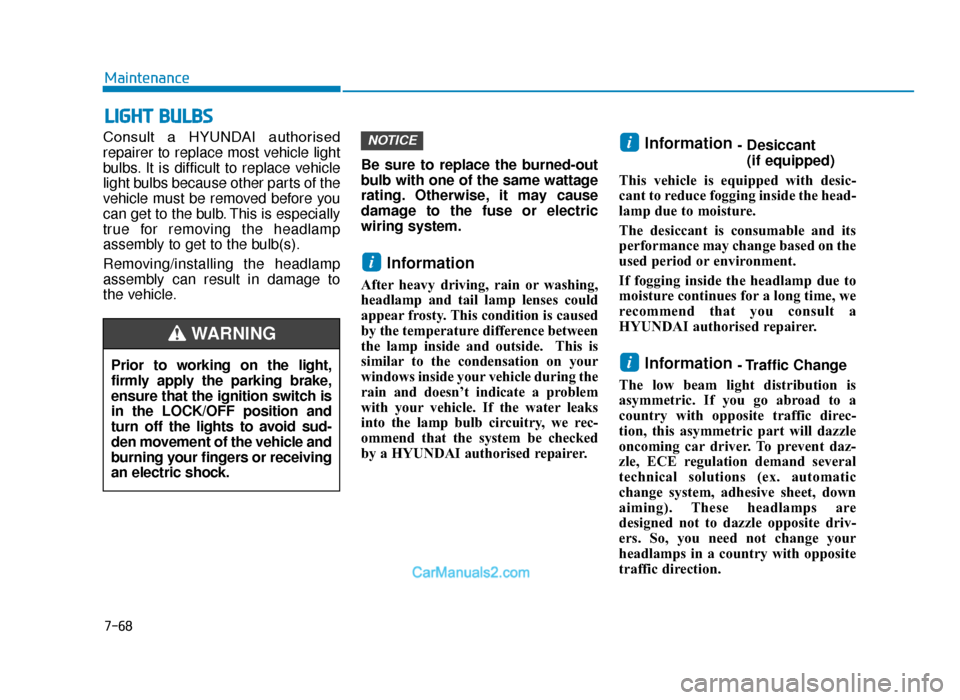
7-68
Maintenance
LIGHT BULBS
Prior to working on the light,
firmly apply the parking brake,
ensure that the ignition switch is
in the LOCK/OFF position and
turn off the lights to avoid sud-
den movement of the vehicle and
burning your fingers or receiving
an electric shock.
WARNING
Consult a HYUNDAI authorised
repairer to replace most vehicle light
bulbs. It is difficult to replace vehicle
light bulbs because other parts of the
vehicle must be removed before you
can get to the bulb. This is especially
true for removing the headlamp
assembly to get to the bulb(s).
Removing/installing the headlamp
assembly can result in damage to
the vehicle.Be sure to replace the burned-out
bulb with one of the same wattage
rating. Otherwise, it may cause
damage to the fuse or electric
wiring system.
Information
After heavy driving, rain or washing,
headlamp and tail lamp lenses could
appear frosty. This condition is caused
by the temperature difference between
the lamp inside and outside. This is
similar to the condensation on your
windows inside your vehicle during the
rain and doesn’t indicate a problem
with your vehicle. If the water leaks
into the lamp bulb circuitry, we rec-
ommend that the system be checked
by a HYUNDAI authorised repairer.
Information - Desiccant
(if equipped)
This vehicle is equipped with desic-
cant to reduce fogging inside the head-
lamp due to moisture.
The desiccant is consumable and its
performance may change based on the
used period or environment.
If fogging inside the headlamp due to
moisture continues for a long time, we
recommend that you consult a
HYUNDAI authorised repairer.
Information - Traffic Change
The low beam light distribution is
asymmetric. If you go abroad to a
country with opposite traffic direc-
tion, this asymmetric part will dazzle
oncoming car driver. To prevent daz-
zle, ECE regulation demand several
technical solutions (ex. automatic
change system, adhesive sheet, down
aiming). These headlamps are
designed not to dazzle opposite driv-
ers. So, you need not change your
headlamps in a country with opposite
traffic direction.i
i
i
NOTICE
TLe UK 7.qxp 5/10/2018 1:38 PM Page 68
Page 618 of 685
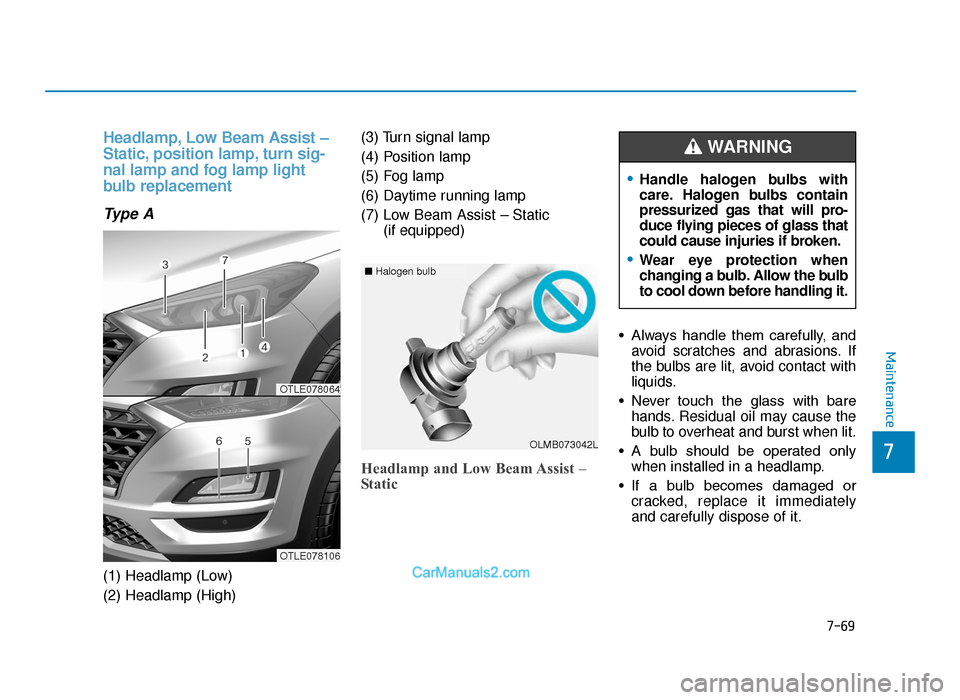
7-69
7
Maintenance
Headlamp, Low Beam Assist –
Static, position lamp, turn sig-
nal lamp and fog lamp light
bulb replacement
Type A
(1) Headlamp (Low)
(2) Headlamp (High)(3) Turn signal lamp
(4) Position lamp
(5) Fog lamp
(6) Daytime running lamp
(7) Low Beam Assist – Static
(if equipped)
Headlamp and Low Beam Assist –
Static
• Always handle them carefully, andavoid scratches and abrasions. If
the bulbs are lit, avoid contact with
liquids.
• Never touch the glass with bare hands. Residual oil may cause the
bulb to overheat and burst when lit.
• A bulb should be operated only when installed in a headlamp.
• If a bulb becomes damaged or cracked, replace it immediately
and carefully dispose of it.
OLMB073042L
•Handle halogen bulbs with
care. Halogen bulbs contain
pressurized gas that will pro-
duce flying pieces of glass that
could cause injuries if broken.
•Wear eye protection when
changing a bulb. Allow the bulb
to cool down before handling it.
WARNING
■ Halogen bulb
OTLE078064
OTLE078106
TLe UK 7.qxp 5/10/2018 1:38 PM Page 69
Page 619 of 685
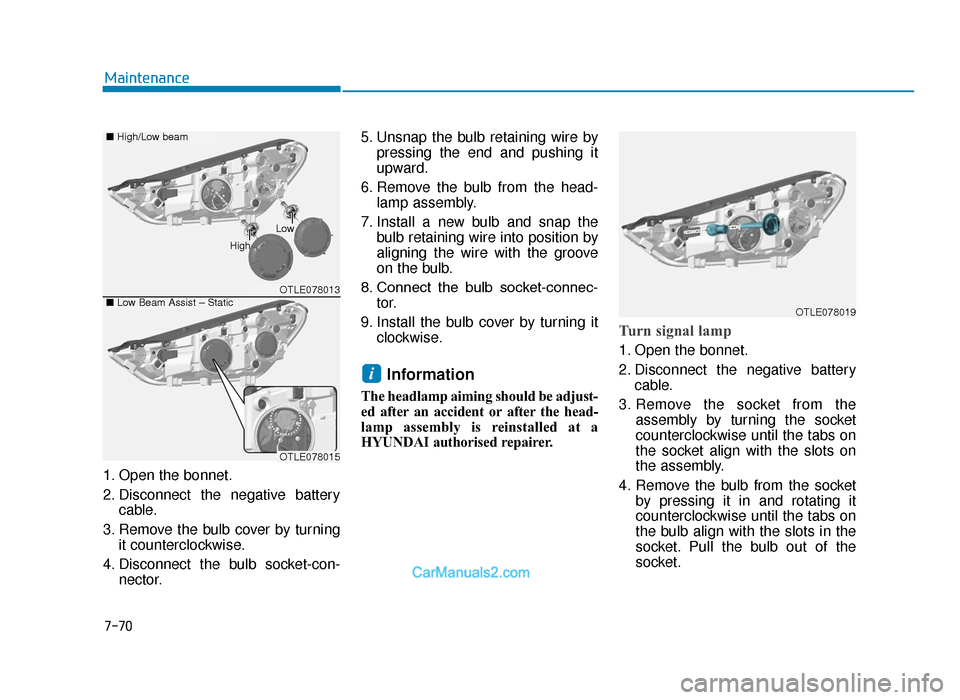
7-70
Maintenance
1. Open the bonnet.
2. Disconnect the negative battery cable.
3. Remove the bulb cover by turning it counterclockwise.
4. Disconnect the bulb socket-con- nector. 5. Unsnap the bulb retaining wire by
pressing the end and pushing it
upward.
6. Remove the bulb from the head- lamp assembly.
7. Install a new bulb and snap the bulb retaining wire into position by
aligning the wire with the groove
on the bulb.
8. Connect the bulb socket-connec- tor.
9. Install the bulb cover by turning it clockwise.
Information
The headlamp aiming should be adjust-
ed after an accident or after the head-
lamp assembly is reinstalled at a
HYUNDAI authorised repairer.
Turn signal lamp
1. Open the bonnet.
2. Disconnect the negative batterycable.
3. Remove the socket from the assembly by turning the socket
counterclockwise until the tabs on
the socket align with the slots on
the assembly.
4. Remove the bulb from the socket by pressing it in and rotating it
counterclockwise until the tabs on
the bulb align with the slots in the
socket. Pull the bulb out of the
socket.
i
OTLE078013
OTLE078015
■Low Beam Assist – Static
■High/Low beam
Low
High
OTLE078019
TLe UK 7.qxp 5/10/2018 1:38 PM Page 70
Page 620 of 685
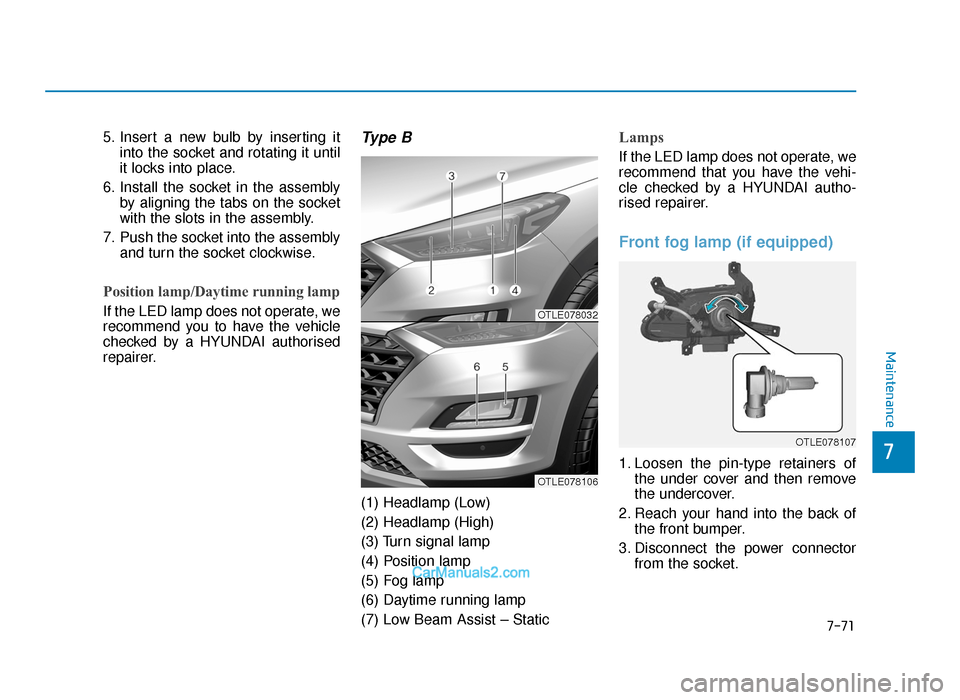
7-71
7
Maintenance
5. Insert a new bulb by inserting itinto the socket and rotating it until
it locks into place.
6. Install the socket in the assembly by aligning the tabs on the socket
with the slots in the assembly.
7. Push the socket into the assembly and turn the socket clockwise.
Position lamp/Daytime running lamp
If the LED lamp does not operate, we
recommend you to have the vehicle
checked by a HYUNDAI authorised
repairer.
Type B
(1) Headlamp (Low)
(2) Headlamp (High)
(3) Turn signal lamp
(4) Position lamp
(5) Fog lamp
(6) Daytime running lamp
(7) Low Beam Assist – Static
Lamps
If the LED lamp does not operate, we
recommend that you have the vehi-
cle checked by a HYUNDAI autho-
rised repairer.
Front fog lamp (if equipped)
1. Loosen the pin-type retainers ofthe under cover and then remove
the undercover.
2. Reach your hand into the back of the front bumper.
3. Disconnect the power connector from the socket.
OTLE078107
OTLE078032
OTLE078106
TLe UK 7.qxp 5/10/2018 1:38 PM Page 71
Page 622 of 685
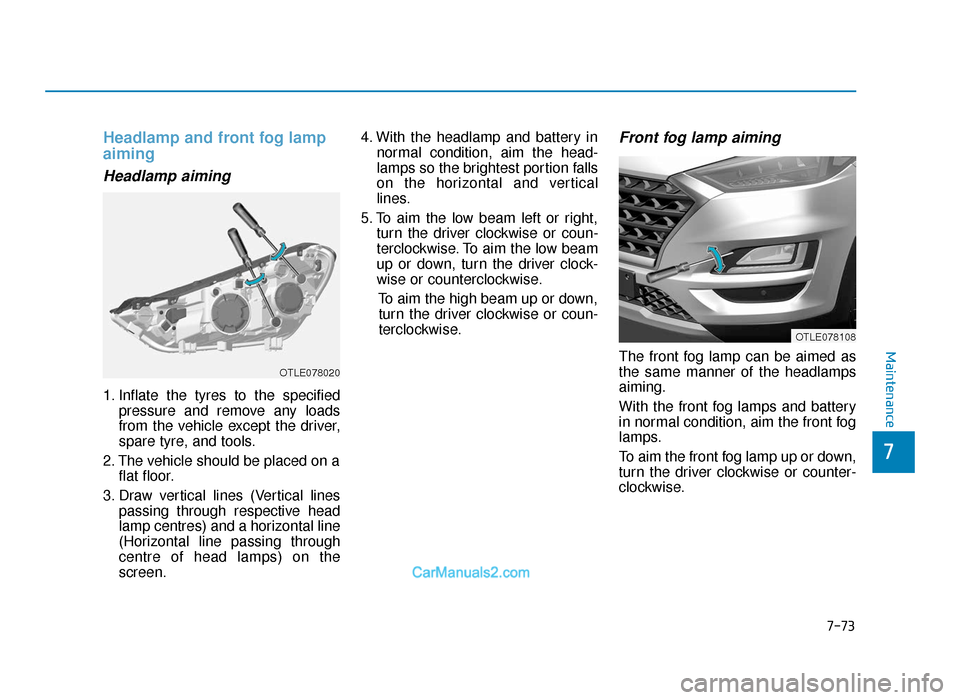
7-73
7
Maintenance
Headlamp and front fog lamp
aiming
Headlamp aiming
1. Inflate the tyres to the specifiedpressure and remove any loads
from the vehicle except the driver,
spare tyre, and tools.
2. The vehicle should be placed on a flat floor.
3. Draw vertical lines (Vertical lines passing through respective head
lamp centres) and a horizontal line
(Horizontal line passing through
centre of head lamps) on the
screen. 4. With the headlamp and battery in
normal condition, aim the head-
lamps so the brightest portion falls
on the horizontal and vertical
lines.
5. To aim the low beam left or right, turn the driver clockwise or coun-
terclockwise. To aim the low beam
up or down, turn the driver clock-
wise or counterclockwise.
To aim the high beam up or down,turn the driver clockwise or coun-
terclockwise.
Front fog lamp aiming
The front fog lamp can be aimed as
the same manner of the headlamps
aiming.
With the front fog lamps and battery
in normal condition, aim the front fog
lamps.
To aim the front fog lamp up or down,
turn the driver clockwise or counter-
clockwise.
OTLE078020
OTLE078108
TLe UK 7.qxp 5/10/2018 1:39 PM Page 73